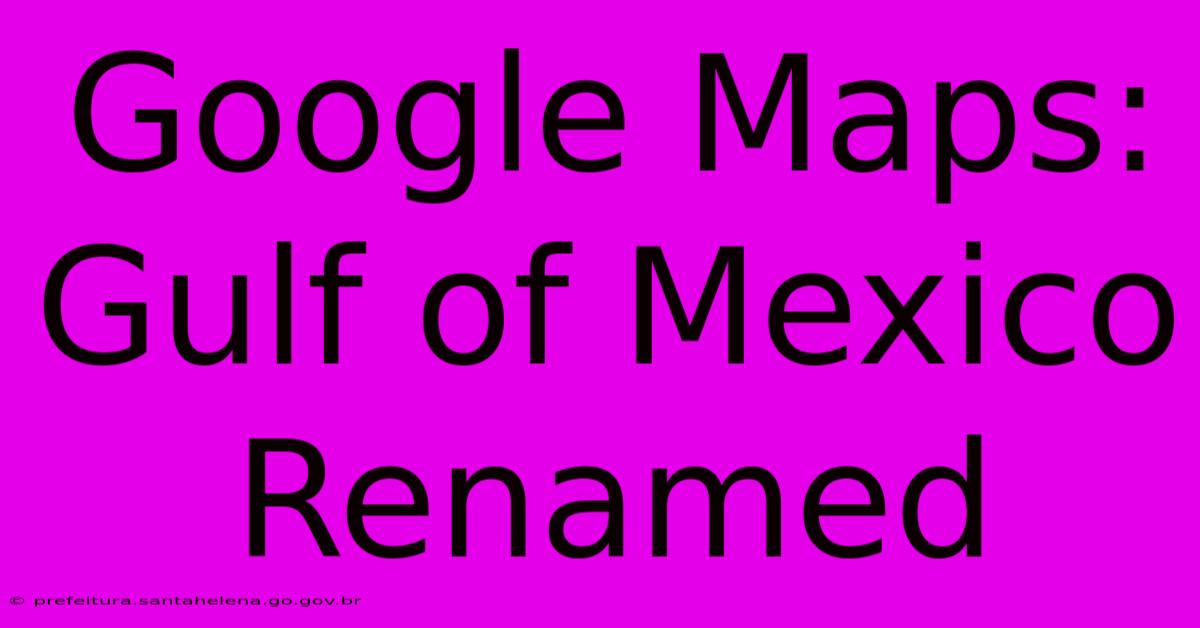Google Maps: Gulf Of Mexico Renamed

Discover more detailed and exciting information on our website. Click the link below to start your adventure: Visit Best Website. Don't miss out!
Table of Contents
Google Maps: Gulf of Mexico Renamed? A Deep Dive into the Rumors and Realities
The internet is abuzz. Social media is alight. Whispers and speculation are swirling around a seemingly impossible claim: the Gulf of Mexico has been renamed on Google Maps. Is this a genuine update, a mischievous prank, a technical glitch, or something more sinister? Let's delve into the heart of this intriguing online phenomenon and untangle the truth from the fiction.
The Initial Spark: Social Media Frenzy
The story began, as many online controversies do, on social media. Posts, tweets, and forum discussions exploded with screenshots allegedly showing a new name for the Gulf of Mexico on Google Maps. These images, often blurry or taken from unusual angles, fueled the flames of speculation. Some claimed to see names like the "Mexican Gulf," "The Great Gulf," or even more outlandish and completely fabricated titles. The lack of consistent naming across these posts immediately raised questions about the authenticity of the claims.
Debunking the Myth: A Critical Analysis
While the initial wave of social media posts created a significant buzz, a closer examination reveals a number of key inconsistencies that cast serious doubt on the veracity of the claims.
-
Lack of Official Confirmation: No official announcement from Google, cartographic agencies, or any relevant governmental bodies has been made regarding a name change for the Gulf of Mexico. Any legitimate geographical name change would be a matter of public record and widely reported by reputable news sources.
-
Inconsistent Naming: As mentioned, the alleged “new names” varied wildly across different social media posts. This inconsistency strongly suggests a lack of a coordinated, genuine change on Google Maps. If a name change were implemented, it would be uniformly applied across all instances of the Gulf of Mexico on the platform.
-
Image Manipulation: Many of the screenshots circulating online showed clear signs of manipulation, including poor image quality, unnatural text overlays, and inconsistencies with the typical Google Maps interface. These factors strongly suggest that many, if not all, of these images were fabricated.
-
The Nature of Google Maps Data: Google Maps is constantly updated, drawing data from a multitude of sources. A large-scale change such as a name alteration for a major geographical feature would require significant internal processes and would be extremely unlikely to occur without public notice.
Understanding the Google Maps Update Process
Google Maps’ vast database is a complex system. Updates are usually incremental and based on verified data from various sources, including government agencies, geographical surveys, and user contributions. Major changes like renaming a large body of water would be subject to rigorous verification processes and would likely take a considerable amount of time to implement consistently across all platforms and languages. The speed and apparent randomness of the reported "renaming" directly contradicts this established process.
The Psychology Behind Online Hoaxes
The rapid spread of this misinformation highlights the susceptibility of online communities to unsubstantiated claims. The power of visual evidence, coupled with a desire for novelty or a pre-existing distrust of authority, creates a fertile ground for the rapid propagation of hoaxes. This phenomenon is amplified by confirmation bias, where individuals tend to interpret information in a way that confirms their pre-existing beliefs.
The Importance of Fact-Checking in the Digital Age
The alleged renaming of the Gulf of Mexico on Google Maps serves as a stark reminder of the crucial role of fact-checking in the digital age. Before sharing or believing information found online, it is essential to verify its authenticity through multiple reliable sources. This includes checking reputable news outlets, government websites, and official statements from relevant organizations. Blind acceptance of information presented on social media or unverified online forums can lead to the rapid dissemination of misinformation and the creation of unnecessary panic or confusion.
Conclusion: Navigating the Digital Landscape Responsibly
The rumor of the Gulf of Mexico being renamed on Google Maps is demonstrably false. The lack of official confirmation, the inconsistencies in the reported names, and the clear evidence of image manipulation all point towards a coordinated hoax or a series of isolated instances of misinformation. This incident serves as a cautionary tale, highlighting the importance of critical thinking and the need to rely on verified information sources in the age of rapid online information dissemination. Navigating the digital landscape responsibly requires vigilance, skepticism, and a commitment to fact-checking before accepting any information as truth. The Gulf of Mexico, for now, remains the Gulf of Mexico, and our understanding of geographical naming conventions remains unchanged. Let's continue to utilize online resources responsibly and combat the spread of misinformation.

Thank you for visiting our website wich cover about Google Maps: Gulf Of Mexico Renamed. We hope the information provided has been useful to you. Feel free to contact us if you have any questions or need further assistance. See you next time and dont miss to bookmark.
Also read the following articles
| Article Title | Date |
|---|---|
| Explore La Bahia Grills Food And Drink Menu | Jan 29, 2025 |
| Rfk Jr Faces Scrutiny On Key Issues | Jan 29, 2025 |
| Caroline Kennedy Condemns Rfk Jr | Jan 29, 2025 |
| Secretary Noems First Nyc Ice Raid | Jan 29, 2025 |
| Leavitts White House Press Debut | Jan 29, 2025 |
| Sixers Win As Davis Suffers Strain | Jan 29, 2025 |
| Kansas Tb Outbreak Two Dead Many Affected | Jan 29, 2025 |
| Milwaukee Welcomes Lillard Back | Jan 29, 2025 |
| Closer To Catastrophe Doomsday Clock | Jan 29, 2025 |
| Fda Expands Lays Potato Chip Recall | Jan 29, 2025 |
